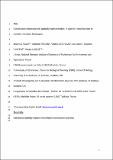Files in this item
Conservation planning with spatially explicit models : a case for horseshoe bats in complex mountain landscapes
Item metadata
| dc.contributor.author | Le Roux, Marie | |
| dc.contributor.author | Redon, Mathilde | |
| dc.contributor.author | Archaux, Frédéric | |
| dc.contributor.author | Long, Jed | |
| dc.contributor.author | Vincent, Stéphane | |
| dc.contributor.author | Luque, Sandra | |
| dc.date.accessioned | 2018-03-22T00:33:06Z | |
| dc.date.available | 2018-03-22T00:33:06Z | |
| dc.date.issued | 2017-05 | |
| dc.identifier | 249468084 | |
| dc.identifier | ad09848f-cd00-4160-a7cc-aea1c532ea48 | |
| dc.identifier | 85015711600 | |
| dc.identifier | 000400233800006 | |
| dc.identifier.citation | Le Roux , M , Redon , M , Archaux , F , Long , J , Vincent , S & Luque , S 2017 , ' Conservation planning with spatially explicit models : a case for horseshoe bats in complex mountain landscapes ' , Landscape ecology , vol. 32 , no. 5 , pp. 1005-1021 . https://doi.org/10.1007/s10980-017-0505-z | en |
| dc.identifier.issn | 0921-2973 | |
| dc.identifier.uri | https://hdl.handle.net/10023/12989 | |
| dc.description | This work was partly Funded by the French Ministry of Ecology, Sustainable Development and Energy, France in support of the development of the DEB-MOCHAB project (2013–2015) (Species distribution modelling: a tool for evaluation the conservation of species’ habitats and ecological continuities). This work was also partially supported by the OpenNESS project funded from the European Union’s Seventh Programme for research, technological development and demonstration under grant agreement n° 308428. | en |
| dc.description.abstract | Context Bats are considered as an ecological indicator of habitat quality due to their sensitivity to human-induced ecosystem changes. Hence, we will focus the study on two indicator species of bats as a proxy to evaluate structure and composition of the landscape to analyze anthropic pressures driving changes in patterns. Objectives This study develops a spatially-explicit model to highlight key habitat nodes and corridors which are integral for maintaining functional landscape connectivity for bat movement. We focus on a complex mountain landscape and two bat species: greater (Rhinolophus ferrumequinum) and lesser (Rhinolophus hipposideros) horseshoe bats which are known to be sensitive to landscape composition and configuration. Methods Species distribution models are used to delineate high-quality foraging habitat for each species using opportunistic ultrasonic bat data. We then performed connectivity analysis combining (modelled) suitable foraging habitat and (known) roost sites. We use graph-theory and the deviation in the probability of connectivity to quantify resilience of the landscape connectivity to perturbations. Results Both species were confined to lowlands (<1000 m elevation) and avoided areas with high road densities. Greater horseshoe bats were more generalist than lesser horseshoe bats which tended to be associated with broadleaved and mixed forests. Conclusions The spatially-explicit models obtained were proven crucial for prioritizing foraging habitats, roost sites and key corridors for conservation. Hence, our results are being used by key stakeholders to help integrate conservation measures into forest management and conservation planning at the regional level. The approach used can be integrated into conservation initiatives elsewhere. | |
| dc.format.extent | 526303 | |
| dc.language.iso | eng | |
| dc.relation.ispartof | Landscape ecology | en |
| dc.subject | Species distribution modelling | en |
| dc.subject | Ensemble modelling | en |
| dc.subject | Expert based knowledge | en |
| dc.subject | Landscape connectivity | en |
| dc.subject | Landscape structure | en |
| dc.subject | Complex mountain landscapes | en |
| dc.subject | Greater horseshoe bat | en |
| dc.subject | Lesser horseshoe bat | en |
| dc.subject | QH301 Biology | en |
| dc.subject | NDAS | en |
| dc.subject.lcc | QH301 | en |
| dc.title | Conservation planning with spatially explicit models : a case for horseshoe bats in complex mountain landscapes | en |
| dc.type | Journal article | en |
| dc.contributor.institution | University of St Andrews. Geography & Sustainable Development | en |
| dc.contributor.institution | University of St Andrews. School of Biology | en |
| dc.contributor.institution | University of St Andrews. Bell-Edwards Geographic Data Institute | en |
| dc.identifier.doi | 10.1007/s10980-017-0505-z | |
| dc.description.status | Peer reviewed | en |
| dc.date.embargoedUntil | 2018-03-21 | |
| dc.identifier.url | https://link.springer.com/article/10.1007%2Fs10980-017-0505-z#SupplementaryMaterial | en |
This item appears in the following Collection(s)
Items in the St Andrews Research Repository are protected by copyright, with all rights reserved, unless otherwise indicated.

